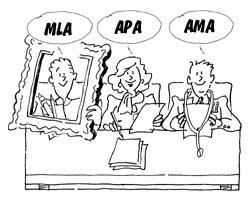

 There are two different ways to do this. You can attach to your paper a list of every source examined, or a list of every source cited.
There are two different ways to do this. You can attach to your paper a list of every source examined, or a list of every source cited.
An alphabetical list of every source examined that led to the topic of a paper is a bibliography. Items on that list may or may not be directly referred to in the text. However, all sources in a works cited or references page must be cited in the text of your paper.? On the other hand, an alphabetized list of only those items that have been to referred to in the text of a paper is usually entitled Works Cited.
Style guides are manuals that provide instructions on how to list sources and provide the necessary information for verification. The most popular guide for the social sciences is published by the American Psychological Association.
There are many software programs that will automatically format your sources for you. NAU's Cline Library provides students free access to RefWorks,
an online reference database program that automatically formats
reference information.
Additional Resources:
Style Manuals and Writing Guides, The University Library of California State, Los Angeles (last accessed 8/2/07).
The Chicago Manual of Style Online, 15th Edition, The University of Chicago Press (last accessed 8/2/07).
Referencing Electronic Media and URLs, The American Psychological Association (last accessed 8/2/07).
This lesson was developed and designed by Amanda Lindsay and Phoebe Morgan